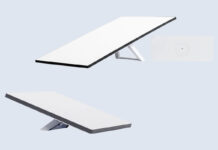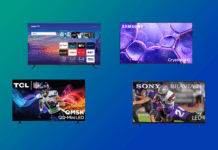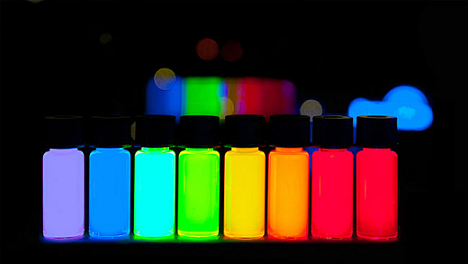 Television technology is constantly changing and being improved. The newest television technology being introduced on the market is LED TVs equipped with Quantum dot technology. Though Quantum dot technology was actually invented back in 1982, it is only now entering the TV market as a way to further improve your television’s picture quality.
Television technology is constantly changing and being improved. The newest television technology being introduced on the market is LED TVs equipped with Quantum dot technology. Though Quantum dot technology was actually invented back in 1982, it is only now entering the TV market as a way to further improve your television’s picture quality.
To understand Quantum dots, also known as QDots or nanocrystals, it’s important to first understand how normal LED-backlit LCD televisions work.
The basics: LED-backlit LCD television technology
When LCD televisions first came on the market, they used florescent tubes to provide a picture, however these components used up way too much power and took up way too much space, resulting in the TVs being bulky. To improve this, tech companies started using LED backlighting. Though this substitution resulted in thinner and more energy-efficient units, the downside was that LED technology produces blue instead of white backlighting. When a TV is backlit with blue light it makes blacks appear brighter than they should and colours appear less vibrant.
So how to does Quantum dot technology fix this?
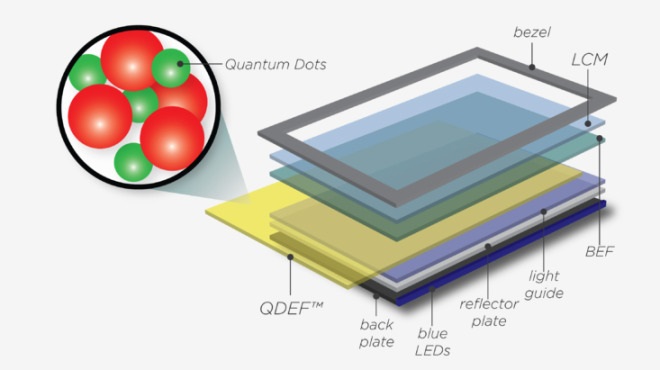 Quantum dots are tiny, light-emitting nanocrystals. These nanocrystals have the ability absorb light at a certain wavelength and change it to another. When added as an extra layer above an LED display, the blue light emitted from the LED backlight is filtered through the Quantum dot nanocrystals and changed into a rich, white light. The small size of these nanocrystals is also advantageous when compared to traditional LCD or LED screens because it is a more effective filter, therefore there is significantly less wasted light, purifying the displayed colour. This results in darker black, more vibrant non-blue colours and an overall improved picture quality. THe image at the beginning on the article shows Quantum dots being irridated with various UV light. Even in these vials you can see the brightness and richness of the colour of the filtering.
Quantum dots are tiny, light-emitting nanocrystals. These nanocrystals have the ability absorb light at a certain wavelength and change it to another. When added as an extra layer above an LED display, the blue light emitted from the LED backlight is filtered through the Quantum dot nanocrystals and changed into a rich, white light. The small size of these nanocrystals is also advantageous when compared to traditional LCD or LED screens because it is a more effective filter, therefore there is significantly less wasted light, purifying the displayed colour. This results in darker black, more vibrant non-blue colours and an overall improved picture quality. THe image at the beginning on the article shows Quantum dots being irridated with various UV light. Even in these vials you can see the brightness and richness of the colour of the filtering.
How does this differ from OLED technology? Is Quantum dot better?
Another way television companies have tried to rectify the blue backlight issues plaguing LED screens is with OLED displays, or organic light-emitting diode displays. OLED display television are the current kings of the high-end television market. With this technology, each pixel produces its own individual backlight rather than one backlight screen within the television. Therefore, if a section of the screen needs to be black, all the pixels in that area will turn completely black, without any light shining through. This results in the same rich black that you get from QDot displays. However, OLED technology is difficult to integrate into displays and therefore very expensive. Since Quantum dot crystals can just be added as an extra layer to normal LED displays, it has the potential to result in far cheaper televisions with just as high-quality a picture display as OLED televisions.
Is it worth it?
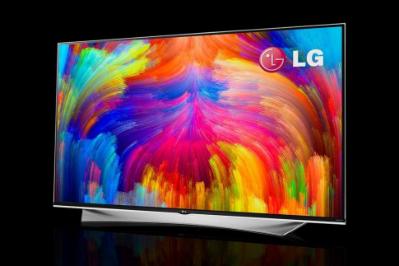
Whether or not you should invest in a Quantum dot television depends on what you currently have. If you recently bought a high-end 4K Ultra HD television, you currently are in possession of a pretty exceptional picture display and I would wait to further upgrade your unit until all the kinks have been ironed out with QDot technology. However, if you’re looking to upgrade your older, 1080p HD television sooner rather than later, you may want to think set your sights on something like the LG UF9500 coming soon to Best Buy. This television is equipped with ColourPrime Nano Spectrum technology, LG’s version of Quantum dots and 4K Ultra HD picture quality. Tom Brauser had the opportunity to recently take a look at this television – check out his first impressions of the UF9500 and other upcoming LG televisions here.
The world of television technology is always evolving. Quantum dot is the latest in television display technology and was one of the most buzzed about terms at this year’s CES. Quantum dots are nanocrystals that can be inserted above currently used LED backlit display systems. These crystals change the backlight from blue to a bright white, resulting in blacker blacks, richer colours and an overall better picture. Quantum dot also markets itself as cost-effective, as it is cheaper to create and install then other high-end television display add-ons, such as OLED. All in all, this new technology might eventually result in high-quality television with top notch picture quality at a surprisingly low price – here’s hoping!
Images from How-To Geek, Wired and Venture Beat.

